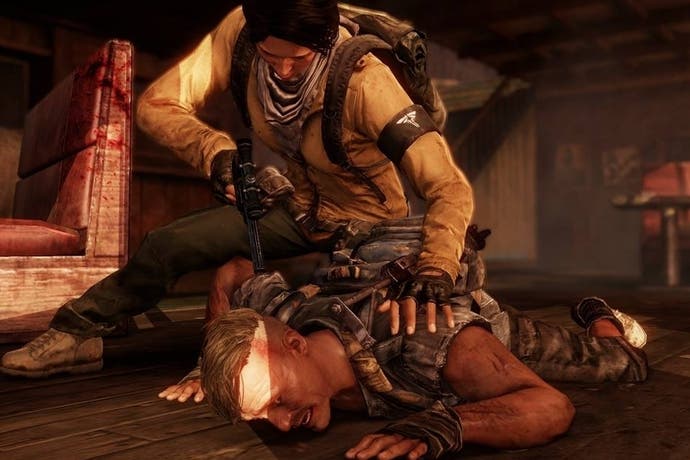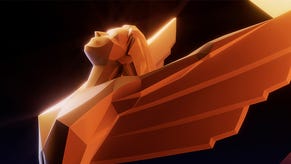Stealth, scavenging, crafting & clans: The Last of Us' multiplayer detailed
How this old Naughty Dog can still learn new tricks.
The Last of Us' multiplayer has been a rather confusing affair with little said about it only a fortnight before the game's launch on 14th June, but today I caught up with its multiplayer designer Erin Daly to explain exactly what it would entail and what makes it different from other third-person competitive shooters.
First off, this will be a much stealthier affair than we're used to. "The competitive multiplayer space is very dominated by these kind of run-and-gun very action-oriented games, and we were really trying to achieve a kind of slower paced, more tactical feel to the game," Daly explains of the game's up to four vs. four multiplayer modes.
This tension is achieved by placing the emphasis on stealth and resource scavenging. Rather than make a beeline to the rocket launcher or frag grenades, you'll have to gather ingredients from around the battlefield like nails, rags, alcohol, knives, and bindings to craft your own gear like nail bombs, molotov cocktails, smoke bombs, shivs, or health packs. Thankfully, this will be done via a very streamlined menu system - which will also be featured in single player - where you can craft objects on the fly without any of the painstaking menu navigation such processes usual employ (sorry, Alone in the Dark).
Since your supplies are limited, it's best not to go all Rambo on the opposing team, and you must instead try to keep a low profile and get the drop on enemies. Knowing there your foes lie while remaining undetected is vital to success and there are plenty of ways The Last of Us' multiplayer system emphasises this.
Players can briefly go into "listen mode," which is like Batman's "detectve mode" for people who aren't detectives, but it still allows you to see through walls via echolocation. Excitingly, there's also a tagging system, where you can "mark" an enemy, making them visible to the rest of your comrades.
Throughout your multiplayer career you'll gain access to new customisation options and survival skills. One of the latter allows you to extend the length of the markers you place, or make marked foes visible behind walls, while other skills allow you to know when you've been marked so you can try to throw off the enemy scent before staging an attack. There's even a high-level survival skill that can prevent you from being marked at all.
These cat-and-mouse mechanics should keep the multiplayer's moment to moment experience engaging, but perhaps The Last of Us' most innovative multiplayer feature is its clan-based meta-game in which you must manage a series of off-screen characters over the course of 12 weeks.
Each player begins with a clan of five people chosen from one of two clans: the Hunters and the Fireflies. Clans are specific to each player, so you don't share responsibilities and everyone has their own off-screen virtual survivalist group to cater to. As you succeed in the multiplayer, your clan will grow. More people means more mouths to feed, more shelter to maintain, and more illnesses to treat before they spread throughout the encampment.
This Oregon Trail-esque framework is tied to what you're doing in the multiplayer game. Say you need to teach your clan some medical abilities after they've suffered a nasty bout of dysentery. You can select a mission that will help bolster their skills in that area - like aiming for a certain number of revives. This way everyone has a sort of ulterior motive that they need to work on to keep their camp happy, not unlike how a post-apocalyptic survivor may rummage for food to feed their starving family back home. It's an emergent story then, but one that has more gravity to it than simply a scorecard at the end of each 10 minute match.
That isn't to say that there isn't also a scorecard at the end of each round dictating how well you did. But even this is tied into the larger meta-game as every action- from a kill, to a revive, to marking a foe - is converted into "parts," the in-game currency. These can be used to purchase new weapons, upgrades, or armour during each round, but whatever parts you don't spend get converted into resources at the end of each round. These resources are what you use to manage your clan.
At the end of the 12 weeks, if your clan is still in good standing you'll receive customisation unlocks like new hats, badges and gestures. The rewards for the clan meta-game are entirely cosmetic, but the unlocks through the rest of the multiplayer are cumulative and practical. You can gain new abilities like running faster or longer, or gaining access to new weapons.
To keep things at least somewhat balanced for new players, there will be preset loadouts that contain high level weapons, but these won't be customisable. So if all you want is a really badass sniper rifle, you can get that right away, but you won't be able to mix-and-match it with other gear and abilities that are tailored to your play style.
One thing that may surprise people is that The Last of Us features only two multiplayer game modes: Supply Raid and Survivor. The former allows you to respawn, while the latter doesn't - though downed members can be revived for a time ala Gears of War's Execution mode. Two modes may not sound like much, but Daly explains, "that was a conscious choice."
"We really focused on depth over breadth. The thinking was really to provide a lot of different layers of tactical choice into the game, as opposed to providing a huge variety of different game modes," he says. "We'd rather have a great game experience with only a couple different modes than an average experience across a wider variety of modes."
Based on Daly's description, both the clan meta-game and the tense pseudo-stealth-based multiplayer sound like a lot of fun, but more than that, they sound unique - which is exactly what a third-person shooter needs to stay current in this post-Gears, post-Uncharted world.
Additionally, Eurogamer Youtube editor Ian Higton actually played The Last of Us' multiplayer. When I ask him about it, he says, "I really enjoyed it. The matches can be pretty tense. Makes a nice change to the normal type of multiplayer."










